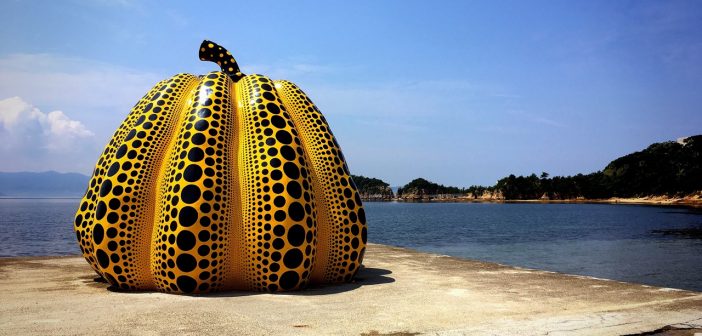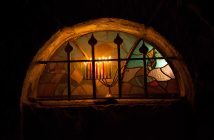Art is highly valued in Japan, not just because of the many artistic disciplines it has given rise to over its history, but also because of the conservation of traditional techniques and having managed to maintain them until the present day. Japan also stands out in the area of modern art, in painting, sculpture, and architecture, as well as the many other disciplines covered by the term. To give you a glimpse into the most emblematic spaces and artists of the Japanese world of modern art, the Japanese Tourism Office has recommended some must-see places and museums for your visit.
Naoshima, the island of modern art
Located on the Seto Inland Sea, Naoshima is a reference point in the country’s modern art scene. Via Benesse Holdings, Inc. and the Fukutake Foundation, the island has been converted into a modern art centre. The space, which covers only 8km2, contains the works of distinguished international artists such as Yayoi Kusama, Claude Monet, James Turrell, and Tadao Ando.
One of the most popular spaces on Naoshima is Benesse House, designed by renowned Japanese architect, Tadao Ando. It is an installation based on the concept of the coexistence of nature, architecture, and art, and incorporates a hotel and museum, as well as other spaces such as a park, restaurant, cafe, spa, and shop. There is art in each of these installations, as well as around them, which allows visitors to interact with works of art no matter where they visit. Among the artworks is one by Japanese artist Yayoi Kusama: two large red and yellow pumpkins located on different sides of the coast.
Benesse House also houses the Chichu Museum of Art, where you’ll find five paintings from Monet’s water lilies series. The museum is also notable for being built almost entirely underground, so as to avoid adversely impacting the environment. The French artist’s influence is also visible outside the museum, in the Chichu Garden, inspired by the gardens at Giverny.
Also built by Tadao Ando, alongside artist Lee Ufan, is the Lee Ufan Museum, where you can see works by the Korean artist, a famous member of the Mono-Ha artistic movement from Japan in the ‘70s. The building itself is a minimalist work of art that invites contemplation of and reflection on the space it occupies.
As well as art in the open air and around various museums, the island manages to fuse everyday Japanese life with art in the Naoshima Baths. This public bath has been converted into an art installation where you can admire paintings by Shinro Ohtake while relaxing.
Teshima, architectural art
Considered the island home of gastronomy due to its seafood, as well as fruit like mandarins, strawberries, and lemons, the island of Teshima also has a reputation for art and architecture. Among its most emblematic sights is the Teshima Museum of Art, designed by artist Rei Naito and architect Ryue Nishizawa, and built in the form of a drop of water. Thanks to its oval-shaped opening, light and air can enter the building, revealing an interior that changes with the seasons.
One of the most important works on the island is “Les Archives du Cœur” by artist Christian Boltanski, an expository work that collects the sound of heartbeats from people all over the world and even lets visitors make a recording of their own.
A visit to Teshima Yokoo House should also be on your itinerary. Created by artist Tadanori Yokoo and architect Yuko Nagayama, the museum is a renovated port-side house and has different environments within. It displays 11 bidimensional artworks and uses tinted windows that allow light, colour, sun, breezes, and the natural nuances of the island to enter and be manipulated. This shows off not only the building but also the exterior and the natural works of art it contains, making the spatial experience of visitors to the house reveal itself as a series of interconnected collages.
Every three years, the islands of Naoshima and Teshima, along with ten other islands from the Seto Inland Sea, host the Setouchi Triennale, an international art festival divided into three sessions – spring, summer, and autumn. As well as an exhibition of sculpture, shows, and specific installations, it hosts events, conferences and workshops related to art.
The futuristic Kanazawa museum
Kanazawa, capital of the Ishikawa Prefecture, is home to the 21st Century Museum of Contemporary Art. Designed by architect Kazuyo Sejima, it’s a circular building with a futuristic exterior. Inside, there are different galleries that flow with other common spaces like a library, conference room, and children’s area.
Apart from the exhibitions and events that are held in this museum, one of the most attractive features is the pool found on one of the patios. This work, created by Argentinian artist Leandro Erlich, looks like a deep pool from the outside, but in reality is only a layer of water about 10cm deep suspended above a transparent sheet of glass. Under the glass, visitors can enter the empty, aquamarine space made by the pool. It’s an experience that makes you reflect on what you consider obvious and to actively participate in the art.
teamLab Museum, pioneers in digital art
teamLab Museum is a pioneer in digital art on a life-size scale. It is located within the Palette Town complex of Odaiba, Tokyo and its full name is “MORI Building DIGITAL ART MUSEUM teamLab Borderless”. Created by company Mori Building, alongside teamLab, a creative and collaborative group that joins professionals from various sectors. It is the first permanent, life-size digital art exhibition. The installation is composed of 520 computers and 470 projectors spread over 10,000m2 and was designed with the aim of eliminating borders by encouraging interaction between art and the public, as well as offering artistic freedom to creators thanks to new technologies.
Yayoi Kusama and her colourful paintings
Yayoi Kusama is one of the most well-known Japanese artists at an international level and also, since 2017, has a museum named after her. In the museum, you will see many of the artist’s pieces, as well a depiction of her artistic career from the earliest moments to the present day, and generally finding out more about her. The museum hosts two exhibitions every year, as well as conferences and events that shine a light on Kusama’s passion for modern art.
Kusama’s work has appeared in many of the main museums, biennials, and triennials of the world. Her paintings are characterised by repetition, colour, and the multiplication of individual motifs, with aspects often found in pop art, especially the concept of paint becoming an element that really impregnates the space it occupies.






